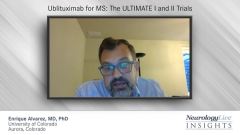
Ublituximab for MS: The ULTIMATE I and II Trials
Experts in the management of multiple sclerosis provide key insights into the use of ublituximab in multiple sclerosis and review results of the ULTIMATE I and II trials from the AAN 2021 Annual Meeting.
Episodes in this series

Lawrence Steinman, MD: Ublituximab is an anti-CD20 monoclonal antibody that’s glycoengineered. It was exceptionally effective in reducing relapse rate and reducing the imaging abnormalities on MRI. It was also very impressive in the number of patients who actually improved in their disability status while getting the medication. There were 2 phase 3 trials with over 1000 patients all over the world. The outcomes were just announced at the AAN [American Academy of Neurology Annual Meeting]. There was a spectacular fall in the relapse rate. It went below a 0.1 of a relapse per year, which hadn’t been seen before.
The great advantage of ublituximab is the fact that you can give it after the first infusion, essentially once every 6 months, and it takes only an hour to infuse it. If you go to an infusion center to get the monoclonal antibody, you can be in and out without wasting half a day sitting around while your infusion is occurring. That’s a potential advantage. Those are my top-line comments about ublituximab, which was a really important addition to the armamentarium of drugs that will be available. It now goes before the regulatory agencies for official approval.
The trials were done in relapsing/remitting MS [multiple sclerosis], so the label will indicate relapsing/remitting MS or secondary progressive MS because there were some patients with the latter. Those are the individuals I would choose for consideration of this medication. With the other anti-CD20s in the class, I would try to match the best choice for a given individual depending on their particular circumstances. Ublituximab is going to be a very important addition to the armamentarium of drugs we have and the choices we can make that best fit what the patient wants.
Some patients will ask, “Is this a new drug? Has it just been approved?” You can tell them, “No, there are 2 other drugs that have been around for a while.” The 1 that’s been around for the longest is ocrelizumab. If there’s a sense that they want to go with something old and proven rather than new and proven, you can go that way. If they say, “I’m a school teacher,” or, “My boss is going to go crazy if I start missing a half a day or more of work every 6 months,” then it would become clear that ublituximab is the best choice. If that doesn’t come up, then Ocrevus or ofatumumab may be the best choice. I always try to match what I think is best for the patient with what they’re going to require.
Of course, discussions with the patient include issues like, “Drug X is going to have to be given by infusion, and you’ll go to an infusion center. Drug Y is given subcutaneously, and you’ll learn how to do it yourself.” If a person says, “I don’t want to do it myself,” then you talk about the infusion center. If a person says, “All my life, I’ve been afraid of needles 1 way or another; I just won’t get a needle,” then you can talk about the oral drug. There’s a good set of choices, and you want to give the individual with the disease the best shot at stopping the disease as you can. Then you look at issues like convenience. And if there’s poor compliance, no matter how good a drug is, it’s has to get into the individual. It’s always good to have the customer pleased with what they’re doing.
Enrique Alvarez, MD, PhD: As we look at new therapies in MS, 1 of the beautiful things is that we’re still getting even more treatments. We recently heard the results of the ULTIMATE I and II studies. There was a press release in December 2020. More important, we saw a lot more of their results presented at the American Academy of Neurology meeting in the middle of April 2021. As we would expect with a lot of CD20 therapies, the data look really impressive. There’s a great advantage in end points compared with teriflunomide, which is what ublituximab was compared with in the ULTIMATE studies.
As I look at these treatments, 1 of the big things that comes up as a differentiator for me is the amount of time we’re infusing these treatments. Much like ocrelizumab, ublituximab is split on the first dose, but then you can do the infusions altogether. The infusions are going to be fairly quick: an hour to an hour and a half. That’s important from a patient’s perspective. Patients don’t like to spend time at the infusion center. If I were a patient, I definitely wouldn’t like to sit at the infusion center. Being able to have that as fast as you can becomes important for the patient. It’s also beneficial for the infusion center because if you can get more patients in, then that helps clear out backlogs. When ocrelizumab came out, we had the capacity to do about 8 long infusions of rituximab in a week. It became really difficult to get a lot of patients in until we modified the schedules to allow more of those patients to come in. We had to extend the hours at the infusion center. Being able to do that becomes important.
Ublituximab also gives us another option in the CD20 realm, which might cause a couple of different changes. We might see insurance companies become a little more accepting of CD20 therapies, particularly as a first-line option. Because there’s competition, we may see some changes in pricing. We might have an improved ability to get some of these medicines. That becomes helpful then in deciding which patients we’re going to use for 1 or the other. You’d have the discussion about the infusion time and what the infusions look like.
It’s going to be hard to separate these medicines on clinical trials. There was little activity, especially from a relapsing perspective, with new lesions, new contrast-enhancing lesions, and clinical relapses in the ublituximab arms of the ULTIMATE studies and the ocrelizumab arm in the OPERA studies, that we then have a difficult time separating these drugs. Things like the convenience and what’s covered by insurance become really important. Having that ability becomes important. One of the nice things about these drugs is it highlights an important concept about our therapies in the sense that we can look at a patient and basically tell them, “We can stop your disease.” These medicines aren’t cures, but they come really close to doing that. The number of patients who we have on these medicines who have disease activity, especially as you start getting past that 6-month or year mark on treatment, is in the single digits. You can look at a patient and say, “There’s a 95% chance plus that you won’t have any disease activity ever after this year, and you’re going to continue to do great.” That’s really reassuring for patients.
Transcript Edited for Clarity
Newsletter
Keep your finger on the pulse of neurology—subscribe to NeurologyLive for expert interviews, new data, and breakthrough treatment updates.






























